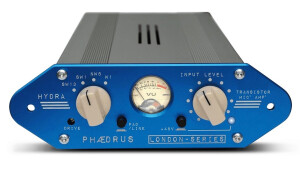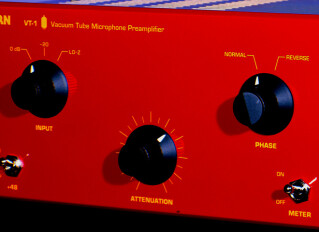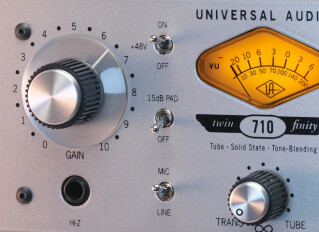Annonces Hydra
Alerte nouvelle annonceFiche technique
- Fabricant : Phaedrus Audio
- Modèle : Hydra
- Série : London
- Catégorie : Préamplis à transistors
- Fiche créée le : 02/11/2017
Préampli micro à transistors basé sur les modèles vintage des années 60 (Abbey Road) pour le studio
- Variable ratio input transformer
- Precision, stepped attenuators
- Multi-rail power supply (to match the feed requirements of each of the preamplifiers)
- Four, independent, solid-state, discrete preamplifiers using a mix of NOS germanium and silicon transistors:
-
- NW8 - A re-creation of the mic' amp' in the the first transistorised console at Abbey Road studios. This mixer replaced the tube mixers and represented a landmark in sound-quality and features. The prototype console was delivered to Abbey Road in the fall of 1968. Just in time to record The Beatles last album, the eponymous "Abbey Road". Read more here.
- TECHIE STUFF: The circuit is an all NPN arrangement running in very low standing-current (<2mA). Internally, the mixer works at a -10dBv operating level and the circuitry therefore has more in common with hi-fi practice than contemporary pro-audio. Unusually too, for a pro-audio design it employs low-noise BC109C transistors. Once again, the BC109C is a favourite amongst hi-fi buffs although it does appear too in Neumann console designs which may have been a significant influence upon this design. Despite the fact that the circuit runs on +/-20V supply rails, the two, common-emitter transistors which "do the work" run on a very low sub-rail (+8V) and this accounts for the limited output swing from this circuit (6v pk-pk). The noise performance from this circuit is very good, the best in the group, but this is necessary given the low operating level. The preamplifier circuit is followed by a 12dB/octave band-pass circuit which does much to define the sound of this classic mixer.
- SW13 - This preamp' is a re-creation of the preamps of the legendary console in Studio 1 at the new Olympic Sound Studios in the London suburb of Barnes. This hybrid silicon/germanium design was a development of the older, all-germanium mixer for the studio in Carlton St. and was the conception which later became the basis of the famous, later Helios consoles. This desk was used by The Rolling Stones, Led Zeppelin, The Small Faces, Traffic, Hawkwind, The Moody Blues, Deep Purple, and Procol Harum, amongst a host of others. The Beatles even used this studio to record "All You Need is Love" and "Baby You're a Rich Man". This is the console of which Glyn Johns said, "There are some desks where, by pure fluke, it actually enhances the sound."
- TECHIE STUFF: This circuit is a forerunner of the famous three-transistor circuit utilised everywhere as a sort of early "op-amp" by Helios. Taking five times the standing current of the Abbey Road preamp, this circuit provides twice the output swing on around half the rail-volts (12V pk-pk on a single 24V rail). Lacking the emitter-follower stage of the Abbey Road preamplifier, this circuit relies on negative feedback to provide a low output impedance from a PNP, Darlington, common-emitter stage. Noise performance is moderate; around 6.5nV/RootHz.
- SW1 - This preamplifier is a re-creation of the mic' preamp in the first, transistorised, professional console anywhere in the world, which was built by Dick Swettenham for the original Olympic Sound Studios in Carlton Street, London. In truth, this entire original mixer is lost. However Swettenham had worked at Abbey Road prior to working at Olympic and , by tracing Dick's subsequent circuit development, and with reference to the earlier designs, we believe we have been able to recreate a very close approximation to the microphone preamps in this landmark console; the desk used to record the early The Jimi Hendrix Experience tracks and The Rolling Stones first single, "Come On". The circuit employs only, new-old-stock (NOS) germanium transistors.
- TECHIE STUFF: This preamplifier is an all-germanium, PNP design running on a slightly lower, negative sub-rail than the later Helios stages; to keep within the safe operating limit of these antique transistors. Effectively an "un-wound" Helios stage, the amplifier contains two, PNP, common-emitter stages; the second being a Darlington stage. Once again, negative feedback assures a low output-impedance. Input noise would be very low from this circuit were it not for the imperfections of germanium transistors which renders them more susceptible to certain noise mechanisms. It is still low however and this stage has a audio signature all of its own.
- W1 - This preamplifier is a recreation of the microphone amplifier in the "A" Range console at Trident studios in London's Soho. This studio opened its doors in 1967 and The Beatles recorded "Hey Jude" and the White Album tracks "Dear Prudence", "Honey Pie", "Savoy Truffle" and "Martha My Dear" there in its earliest days. And George Harrison returned to Trident to record the wonderful "All Things Must Pass" album. Queen, David Bowie, Black Sabbath, Elton John, T.Rex, Carly Simon, Frank Zappa, Lou Reed, Rod Stewart, Genesis and Supertramp all recorded at Trident.
- TECHIE STUFF: The Trident circuit is the greediest of all, taking ten times the standing current of the Abbey Road circuit! It consists of a common-emitter circuit feeding a push-pull output stage, the whole wrapped in a healthy dose of negative feedback. Due to a resistive divider circuit on the input, the preamplifier has the highest noise level of all the stages here (20nV/rootHz). But it has a healthy output swing (13v pk-pk), the best of the group.
- NW8 - A re-creation of the mic' amp' in the the first transistorised console at Abbey Road studios. This mixer replaced the tube mixers and represented a landmark in sound-quality and features. The prototype console was delivered to Abbey Road in the fall of 1968. Just in time to record The Beatles last album, the eponymous "Abbey Road". Read more here.
- Max gain +50dB
- VU meter (0VU = 0dBu)
- All levels are normalised within the unit so that the output (irrespective of mic' amp selected) is returned to 0VU= 0dBu level.
- Suitable for all microphones:
- Switchable pad on input
- Phantom power (+48V)
- Powered by the PHUEL, or a "wall-wart" type PSU
»





